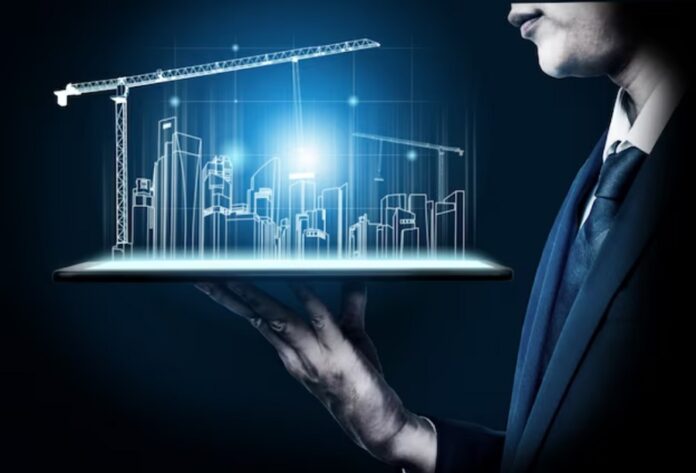The real estate industry is undergoing a digital evolution. New technologies and innovations are profoundly changing how we think about, build, and operate real estate assets. This digital transformation is having a significant operational impact across the real estate sector.
Real estate is digitizing rapidly. From virtual property viewings using digital twins, and digital building information modeling for design and construction, to data-driven smart building management systems – digital technologies are reshaping real estate.
Digital real estate refers to the incorporation of digital technologies, tools, and solutions across the real estate life cycle. This includes activities like land and property searches, marketing, viewings, property management, building operations, and facility maintenance. The digital evolution encompasses both residential and commercial real estate segments.
The significance of this digital evolution is evident in its rapid pace and extensive reach. Digital disruption has touched upon almost every real estate activity and process. It has modified stakeholder interactions, optimized operations, created new revenue opportunities, and provided end-users with more convenience and transparency.
This ubiquitous adoption of technology is also operationally transformative. Digital capabilities change how real estate assets are designed, built, operated, managed, bought/sold, leased, and financed. Traditional workflows and processes require upgrades to align with digitally-driven models.
This article examines the key aspects of the digital evolution of real estate and its implications for operations across the property life cycle.
Digital Technologies Transforming Real Estate
Various technologies and tools are catalyzing the digital transformation of real estate:
Overview of Key Technologies Reshaping Real Estate
- Cloud computing infrastructure
- Big data and analytics
- Artificial intelligence and machine learning
- Virtual and augmented reality
- Building information modeling (BIM)
- Smart sensors and Internet of Things (IoT) devices
- Blockchain-based property transactions
- Drone property inspections and mapping
Of particular significance is the adoption of information communication technology (ICT) solutions for properties. ICT encompasses connected sensors, automated controls, integrated software, and analytics dashboards. It enables remote monitoring, reductions in operating costs, and data-based decision-making for real estate owners and managers.
Examples of ICT capabilities include:
- Digital twin models for virtual property viewings and design experimentations
- Remote building inspections using drones and 360 photography
- Customizable digital property listings with interactive features
- Automated lighting, HVAC, and security controls
- Centralized BMS and analytical dashboards
- Predictive maintenance alerts and energy optimization
1) Virtual Viewings and Digital Twins Drive New Customer Experiences
Virtual viewings utilizing digital twin models of homes/buildings are enhancing customer experiences and conversations. Property seekers can digitally explore every corner of the asset without physically traveling. Digital twins also assist during property handover by identifying defects ahead of possession.
360 photography, videography, augmented overlays on camera feeds, and embedded interactive elements provide further enrichments. Together they transform static listings into dynamic digital experiences.
2) Smarter Design with Generative Design and Digital Building Models
Generative design, an AI-based technique, produces numerous design iterations meeting specified goals. It enhances architects’ capacities for unconventional and optimized building creation.
Rich digital building information models combine architectural, mechanical, electrical, plumbing, and other asset data. Design experimentation, clash detections, construction sequencing, and facilities management benefit from data-connected BIM models.
3) Drone Innovation Takes Property Surveying and Mapping to New Heights
Aerial property mapping using camera-equipped drones provides faster, cheaper, and more regular outdoor surveying. The bird’s eye view enables better property inspection, 3D modeling, and change detection capabilities. Infrared and LiDAR drones can identify material defects too.
Easy integration of drone data with geospatial analytics tools empowers deeper location-based intelligence too. Property and facilities managers utilize such geospatial insights for decision support.
Technological Impact on the Real Estate Industry
Digital innovation has caused sweeping changes across the real estate sector:
- Faster buying/selling and leasing enabled by online listing platforms
- Rise of data and analytics driving intelligence in design, construction, and asset management
- Optimized operations and reduced costs via connected IoT monitoring
- New revenue opportunities using enhanced space utilization and hybrid business models
- Improved sustainability performance empowered by smart energy and water management
- Higher transparency and customer empowerment due to easy online access to information
In particular, digital technology adoption has strategic implications for real estate businesses:
- Pressure to rapidly digitize existing portfolios and align teams to leverage new innovations
- Develop specialized in-house digital capabilities through upskilling programs or external partnerships
- Modify outdated processes to integrate emerging construction methods like Design for Manufacturing and Assembly (DFMA)
- Utilize technology for competitive differentiation and market leadership
Overall, technology is stimulating much-needed modernization while transitioning real estate to more customer-centric, sustainable, and intelligent business models.
The Great Reset: A New Era for Real Estate
The digital revolution and its impact have led experts to describe an impending ‘Great Reset’ for real estate.
Thought leaders emphasize how the sector must shift towards new ways of thinking, building, and operating real estate to thrive in a post-COVID world.
One key driver is remote working models rapidly transforming office space demand. A hybrid blend of work-from-home and office-based work is emerging. To adapt, offices require reconfiguration into spaces promoting collaboration and innovation.
The report “The Great Reset: The Future of Offices and Commute” provides valuable insights into upcoming real estate trends influenced by remote work:
“Buildings need to work harder to attract tenants in an era where using office space is a choice, not a requirement”
“Commutes will be different – less frequent with more flexibility needed from public transit”
Such observations indicate that the digital evolution serves as an accelerator for the new hybrid real estate era. Technologies that enable seamless remote collaboration, data-driven space planning, and flexible property use cases are essential for a thriving future.
Digitalization and Sustainability in Real Estate
An often overlooked aspect is the close linkage between digitalization and sustainability in the built environment.
Environmentally conscious planning, net zero construction methods, and smart energy management rely heavily on digital capabilities. Data analytics, IoT-enabled systems, and automation are crucial for evidence-based decisions and measurable improvements in real estate sustainability.
Some examples of tech-enabled sustainability benefits include:
- Reduced material wastage through predictive demand planning and inventory optimization
- Energy savings from real-time HVAC and lighting management based on building occupancy
- Water conservation using a centralized Building Management System (BMS) to monitor leakages and consumption patterns
- Lower carbon footprint by integrating renewable energy sources and enabling electric vehicle charging
Therefore, sustainability-minded owners must invest in digital infrastructure and smart systems to drive green performance.
Regulatory policy changes also nudge the real estate industry to decarbonize portfolios. Digitalization assists in the required transition through detailed measurement, verification, and reporting mechanisms.
Opportunities for Digitization in Real Estate
The accelerating digital transformation brings tremendous opportunities for further technology integration across homes, offices, malls, healthcare campuses, industrial setups, and smart cities.
Trends and Topics Shaping the Digital Future of Real Estate
Multiple technology trends are positively disrupting the sector:
Smart Infrastructure
Integrated software, connected equipment, automation, drones, and predictive analytics will stimulate intelligent and self-optimizing buildings and city infrastructure.
Augmented Working
Spatial computing solutions blending augmented reality with building data models support next-gen collaboration, design, construction, and facilities management.
Digital Platformization
Fragmented real estate subsectors like property management and facilities maintenance will undergo a platform-based aggregation into consolidated digital experiences and services.
Embedded Property Tech
Appliances, lighting, security systems, etc. will contain in-built intelligence for sustainability, convenience, and predictive insights.
Neighborhood Analytics
Geospatial analytics will assist real estate investment decisions using granular insights on surrounding site conditions, existing infrastructure, zoning policies, etc.
These technology topics demonstrate the scope for ongoing digitization across real estate segments to deliver customer-centricity, operational efficiency, and future readiness.
Operational Impact of Digital Evolution in Real Estate
While digital innovation promises tremendous benefits, effectively capitalizing on emerging technologies requires significant upgrades in operational capacities:
Real Estate Design and Development
Traditional design principles must adapt to utilize new materials, construction approaches like DFMA, and highly efficient building performance. Augmented and virtual modeling shape early design phases. On-site capabilities also require improvement – digital skillsets for crews, compatible equipment, and tools leveraging IoT and analytics.
Reliable connectivity, smart sensors, drones, and wearables gradually increase adoption. Together, these drive more data-driven decision-making during design development and onsite construction.
For example, project managers can virtually tour 3D building models with embedded QR codes linking to material orders and equipment data sheets. Biometric sensors provide safety and fatigue monitoring for workers. Real-time progress dashboards integrate drone footage, construction camera feeds, and schedule milestones to enable remote monitoring.
Such digital enhancements introduce complex data streams that must synchronize with legacy documentation tools. The operational challenge lies in unifying virtual design platforms, collaboration software, project management systems, and financial reporting in a common data environment.
Property and Facilities Management
Managers overlook expanding portfolios of smarter buildings, sensors, automated equipment, and analytics tools requiring specialized attention.
Building automation relies on the expertise to maintain connectivity, implement cybersecurity protocols, and leverage captured IoT data. Skills related to data science, AI, and coding rise in criticality for effective property management.
Vendors proliferate in the proptech space leading to fragmented data flows. A key operational priority is consolidating protect applications into unified command centers or integrated workplace management systems (IWMS). Centralized software avoids teams toggling between disconnected apps.
Transitioning from dated pen-and-paper modes, enterprise mobile applications enable asset monitoring, on-demand services, maintenance workflows, inventory management, etc. Wearables further assist technicians execute tasks hands-free.
Despite noteworthy innovations, limited legacy building integration hinders large-scale smart infrastructure benefits. Owners gradually implement digital retrofits into existing properties to bridge the gap.
Future Outlook
Industry reports consistently highlight the nascent stage of digital adoption with an expectancy for more immersive transformation.
Prominent analyst Josh Ridley notes:
“2022 marked a record year for proptech investment. But the Hard Hat era has just begun – we are only at 1% disruption.”
His emphasis on the initial phase of disruption despite rapid funding growth signals the long runway ahead.
Expert consensus emphasizes certain future trends in digital real estate:
- Mainstream implementation of augmented workflows, digital twins, and blockchain-enabled transactions
- Developers and asset managers prioritize technology and sustainability in tandem
- Constructed spaces become multifunctional platforms via reconfigurable building design
- Workplaces investing heavily in smart services and environment quality to attract talent
- Cities embracing smart districts and developing technology-focused zones
Nevertheless, scaling technology innovation across portfolios remains challenging. Achieving widespread operational transformation requires overcoming adoption barriers like change management, skills development, cyber risks, and incompatible legacy systems.
In conclusion, the digital revolution in real estate promises improved sustainability, efficiency, transparency, and experiences for all stakeholders. While promising, effectively harnessing its advantages involves a commitment from owners, operators, and municipalities to usher the industry into a technologically integrated future.






